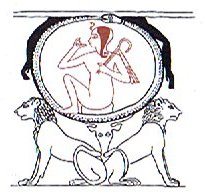4. In the text of G we can count from Sun's 'birth' as Rogo in Gb6-26 and 300 days a-head we can find his 'death':
Rogo is not Harpocrates, he is not sucking, and he is looking straight at us, standing quite still. This is probably the right place to underline that the number of glyphs on side a, if we count from Ga1-1 up to and including the last of them (Ga8-26), is not 230 but 229. The 'front side' of the text is beginning not with Ga1-1 but with Gb8-30, and it ends with Gb1-6:
In other words, we must count Gb8-30 (where 8 * 30 = 240) twice. It is both the last glyph on the 'back side' and the first glyph of the 'front side'. Evidently it means that there should not be a break in time between the end of side b and the beginning of side a. The cycle of time must be closed. The 'eternal serpent' is 'eating its tail':
I have copied this picture from Richard H. Wilkinson's Hieroglyfernas värld ('Reading Egyptian Art'). Note the black arms and at bottom the lions. Winter (or night) is where the head of the serpent bites his tail. The hands probably mark the equinoxes (or daybreak respectively sunset). The snake head is not exactly straight up, it is coming slightly after 'midnight', and the black hand of night stretches longer towards the morning lion. It has straight fingers, whereas the black hand of evening is formed otherwise. |
||||||||||||||||||||||||||||||||


